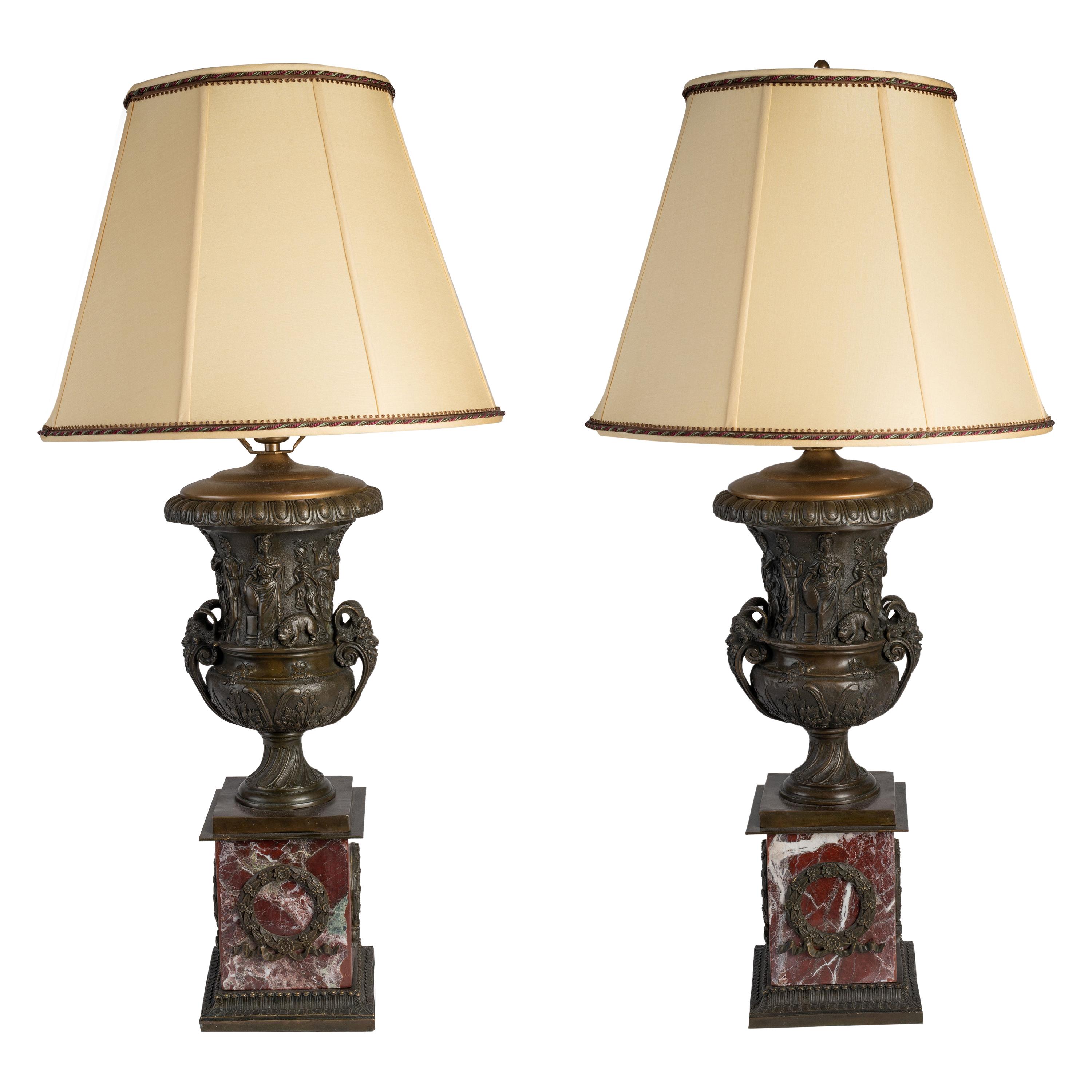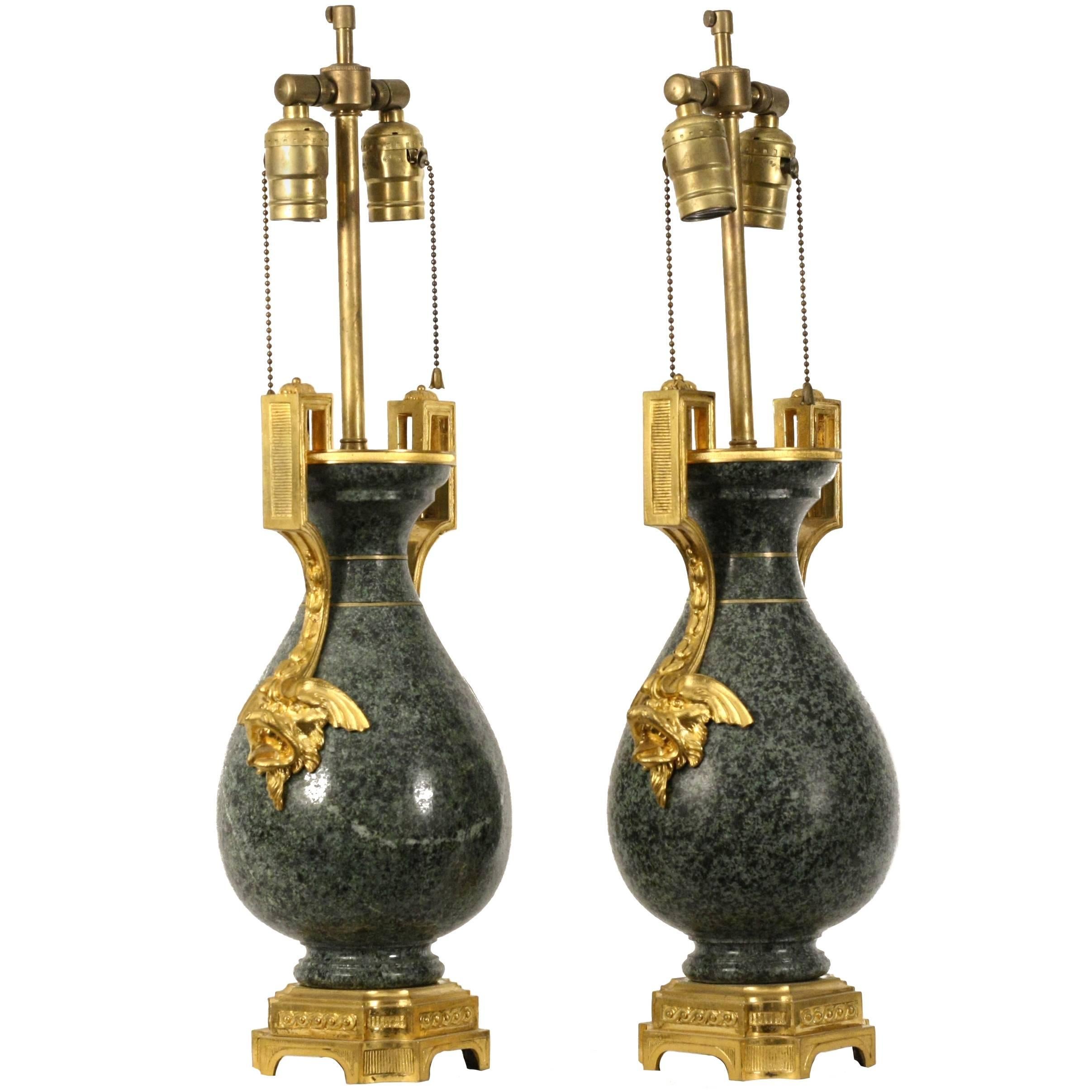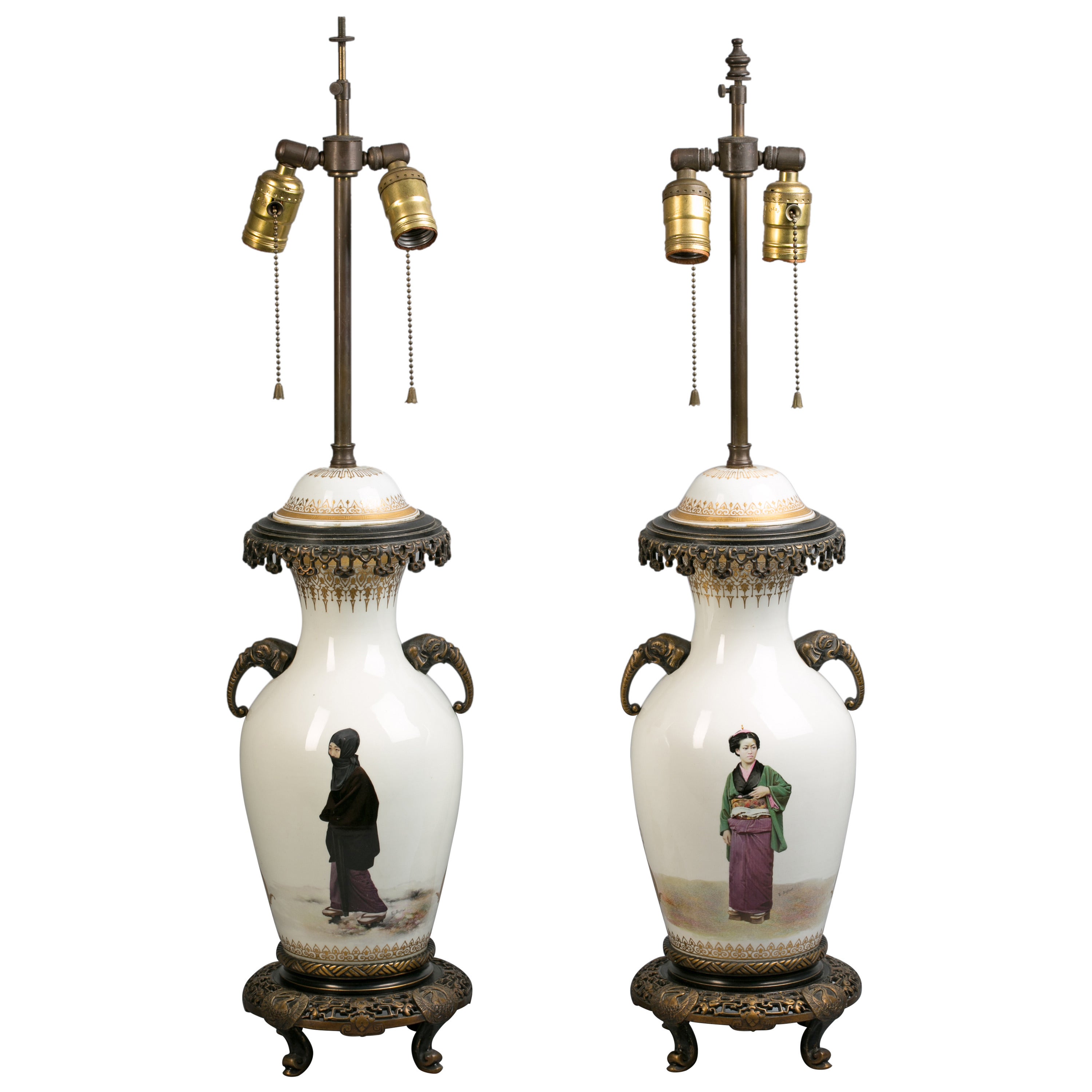Items Similar to Pair French Patinated Bronze and Ormolu Vases Mounted Table Lamps
Video Loading
Want more images or videos?
Request additional images or videos from the seller
1 of 20
Pair French Patinated Bronze and Ormolu Vases Mounted Table Lamps
About the Item
A pair of two-handled vases / lamps in classic French Napoleon III style bronze and gilt ormolu of very good quality, each with a foliated plant decoration in bronze, the ormolu ornaments with shields and hanging drapery motifs. the handles are very original, these vases were electrified and mounted as table lamps with double bulbs.
- Dimensions:Height: 31.11 in (79 cm)Width: 11.82 in (30 cm)Depth: 11.82 in (30 cm)
- Sold As:Set of 2
- Power Source:Plug-in
- Voltage:110-150v
- Lampshade:Not Included
- Style:Napoleon III (In the Style Of)
- Materials and Techniques:
- Place of Origin:
- Period:
- Date of Manufacture:1890
- Condition:Rewired. Wear consistent with age and use. Minor losses.
- Seller Location:Madrid, ES
- Reference Number:1stDibs: LU954333574391
About the Seller
4.7
Gold Seller
These expertly vetted sellers are highly rated and consistently exceed customer expectations.
Established in 2012
1stDibs seller since 2012
157 sales on 1stDibs
Typical response time: <1 hour
- ShippingRetrieving quote...Ships From: Madrid, Spain
- Return PolicyA return for this item may be initiated within 10 days of delivery.
More From This SellerView All
- Pair of French Patinated Bronze Vases Urns Clodion StyleBy Claude Michel ClodionLocated in Madrid, ESA pair of late 19th century French vases or urns, in the style of C.M.Clodion, in patinated bronze with a Belgian black marble base. The vase...Category
Antique Late 19th Century French Renaissance Revival Urns
MaterialsMarble, Bronze
- Pair 20th Century Art Deco Marble and Bronze Urns VasesLocated in Madrid, ESA pair of impressive and large vases or urns from the Art Deco period, made of white marble and patinated bronze, the cups in the shape of an amphora or Greco-Roman vessel, are suppo...Category
Mid-20th Century French Art Deco Urns
MaterialsMarble, Bronze
- French Maison Charles Style Chromed and Stone Table LampBy Maison CharlesLocated in Madrid, ESA table lamp from the 70s, in the style of the Maison Charles, in chrome and nickel-plated metal and the central ball in marbled stone, the wiring is new in black silk cord and the l...Category
Late 20th Century French Mid-Century Modern Table Lamps
MaterialsMarble, Metal, Chrome
- Art Deco French Brass and Metal Lacquered Desk Table LampLocated in Madrid, ESDesk table lamp, from the 1940s, made of Bakelite, lacquered metal and brass. The ignition is done by rotating the brass circle at the base, it has three bulbs and the shade is curr...Category
Mid-20th Century French Art Deco Table Lamps
MaterialsBrass
- Pair of Whithe and Red Swedish Luxus Glass Table LampsBy Luxus of SwedenLocated in Madrid, ESPair of Swedish modern qpaque white and red glass table lamps, The lamps combine the color white and red in the central column and the lampshades a...Category
Mid-20th Century Swedish Mid-Century Modern Table Lamps
MaterialsBlown Glass, Plexiglass
- Pair of Carved Alabaster Table LampsLocated in Madrid, ESA pair of table lamps in carved alabaster, garland and gullonado decoration. The lamp shades in White plasticized linen and gold interior. The measurements are with the lampshade i...Category
Mid-20th Century Spanish Neoclassical Revival Table Lamps
MaterialsAlabaster
You May Also Like
- Pair of French Ormolu-Mounted Blue-Ground Porcelain Vases Fitted as LampsLocated in New York, NYA fine quality pair of French Ormolu-Mounted Chinese Porcelain Vases mounted as lamps in mottled blue-ground glaze. Resting on square ormolu base with garland band and ormolu banded ...Category
Antique 19th Century French Chinoiserie Table Lamps
MaterialsBronze, Ormolu
- Pair of Neoclassical Patinated Bronze and Red Marble Urns Mounted as LampsLocated in Kittery Point, MEEach urn cast with frieze of classical figures, raised on a bronze-mounted rouge griotte square marble base. The lampshades are silk and custom made by Blanche Field...Category
Antique Late 19th Century French Neoclassical Table Lamps
MaterialsGriotte Marble, Bronze
- Pair of French Ormolu and Patinated Bronze Caryatid LampsLocated in Pembroke, MAPair of elegant gilded bronze and patinated bronze candelabra in the form of caryatids on black marble plinths, which have been converted into lamps with custom silk pleated shades.Category
Antique 19th Century French Louis XVI Table Lamps
MaterialsMarble, Ormolu, Bronze
- Pair of 19th Century Ormolu-Mounted Granite VasesLocated in New York, NYPair of French vases with ormolu mounts on granite, now mounted as lamps.Category
Antique 19th Century French Vases
MaterialsGranite, Ormolu
- Pair of Bronze-Mounted French Porcelain Lamps, circa 1885Located in New York, NYPair of bronze-mounted French porcelain covered vases mounted as lamps, circa 1885. Signed Eugene Sieffert. The elephant handles are bronze.Category
Antique 1880s Table Lamps
MaterialsBronze
- Pair of Porcelain Vases Ormolu-Mounted in Lamps by Gagneau Paris XIXth CenturyBy Gagneau ParisLocated in Saint-Ouen, FRPair of large Japanese Porcelain Cone Shape Vases with Imari decoration Important mounts in ormolu and gilded metal, the base decorated with a laurel wreath, the upper part of falling leaves and a frieze of knotted ribbon. The mounts signed Gagneau, 115 R. Lafayette. Circa 1860 With their original aluminium bulb cover and original gilding Vase it self Height 47 cm The Gagneau Company is one of the most famous lighting factories in Paris in the nine-teenth century, established in 1800 at 25 rue d'Enghien in Paris and later at 115 rue de Lafayette. She has participated in many exhibitions throughout this century. She began in 1819 with the Exposition des Produits de l'Industrie and later participated in the Universal Exhibitions where she was part of the jury in the category of art bronzes (class 25) at the Universal Exhibition in Paris in 1889. "Imari" was simply the trans-shipment port for Arita wares, from where they went to the for-eign trading outposts at Nagasaki. It was the kilns at Arita which formed the heart of the Japanese porcelain industry. Arita's kilns were set up in the 17th century, after kaolin was discovered in 1616. A popular legend attributes the discovery to an immigrant Korean potter, Yi Sam-Pyeong (1579–1655), although most historians consider this doubtful. After the discovery, some kilns began to produce revised Korean-style blue and white porcelains, known as Early Imari, or "Shoki-Imari". In the mid-17th century, there were also many Chinese refugees in northern Kyushu due to the turmoil in China, and it is said that one of them brought the overglaze enamel coloring technique to Arita. Thus Shoki-Imari developed into Ko-Kutani, Imari, and later Kakiemon, which are sometimes taken as a wider group of Imari wares. Ko-Kutani was produced around 1650 for both export and domestic market.Kutani Ware is characterized by vivid green, blue, purple, yellow and red colors in bold designs of landscapes and nature. Blue and white porcelain pieces continued to be produced and they are called Ai-Kutani. Ko-Kutani Imari for the export market usually adopted Chinese design structure such as kraak style, whereas Ai-Kutani for the domestic market were highly unique in design and are ac-cordingly valued very much among collectors. Ko-Kutani style evolved into Kakiemon-style Imari, which was produced for about 50 years around 1700. Kakiemon was characterized by crisp lines, and bright blue, red and green designs of dramatically stylized floral and bird scenes. Imari achieved its technical and aes-thetic peak in the Kakiemon style, and it dominated the European market. Blue and white Kakiemon is called Ai-Kakiemon. The Kakiemon style transformed into Kinrande in the 18th century, using underglaze blue and overglaze red and gold enamels, and later additional colors. Imari began to be exported to Europe when the Chinese kilns at Jingdezhen were damaged in the political chaos and the new Qing dynasty government halted trade in 1656–1684. Ex-ports to Europe were made through the Dutch East India Company, and in Europe the des-ignation "Imari porcelain" connotes Arita wares of mostly Kinrande Imari. Export of Imari to Europe stopped in mid-18th century when China resumed export to Eu-rope, since Imari was not able to compete against Chinese products due to high labor costs. By that time, however, both Imari and Kakiemon styles were already so popular among Eu-ropeans that the Chinese export porcelain copied both, a type known as Chinese Imari. At the same time, European kilns, such as Meissen and English potteries such as Johnson Bros. and (Royal) Crown Derby, also imitated the Imari and Kakiemon styles. Export of Imari surged again in late 19th century (Meiji era) when Japonism flourished in Europe.Thus, in the western world today, two kinds of true Japanese Imari can...Category
Antique 1880s French Japonisme Table Lamps
MaterialsBronze
Recently Viewed
View AllMore Ways To Browse
Plant Decoration
Ormolu Mounted Table
Bronze Ormolu Table
Lamps Ormolu Mounted
Gilt Table Lamps Ormolu
French Plant Tables
Antique Double Lamp
Two Handle Lamp
Bronze Lamp Handle
Ormolu European Bronzes
Hanging Plants
Hanging Plant
Classic Table Lamp French
Plant Table Lamp
Vase Lamp With Handles
Hanging France Lamp
Napoleon Gilt Bronze Table
Double Bulb Table Lamp





